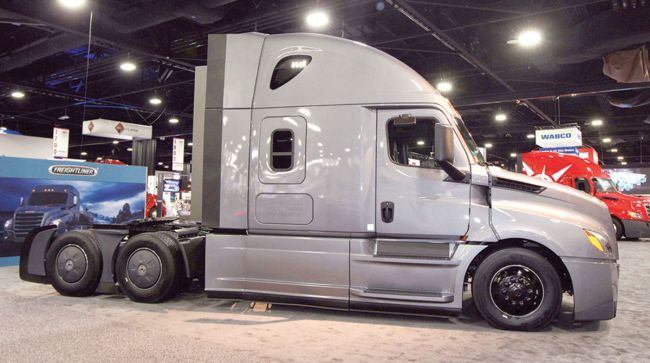A Freightliner truck on display at an industry trade show. Freightliner is a brand of Daimler Truck North America. (John Sommers II for Transport Topics)
Daimler Truck AG posted a net profit of $1.101 billion in the three months that ended June 30, compared with $1.037 billion in the year-ago period, the company said Aug. 1.
The Leinfelden-Echterdingen, Germany-headquartered company reported earnings per share of $1.22 compared with $1.23 a year earlier. The company reports in euros.
Daimler Truck’s revenue totaled $15.25 billion in the most recent quarter, compared with $13.27 billion in the 2022 period.
Freightliner and Western Star’s overall parent company said worldwide vehicle sales increased 9% in the second quarter to 131,888 from 120,961 a year earlier.
The company produced 132,646 vehicles in the most recent quarter, a 4% increase from 126,935 a year earlier,
Daimler Truck North America — which includes Freightliner and Western Star — saw a 15% jump in vehicle sales to 50,618 in the most recent quarter from 44,124 a year earlier. Of those regional sales, some 42,709 came in the U.S., an 18% jump compared with 36,187 in 2022.
DTNA reported revenue of $6.55 billion in the three months that ended June 30, compared with $5.65 billion in the same period a year earlier, a 16% jump.
The revenue increase was driven by significantly higher sales volumes, improved net pricing and an improvement in the aftersales business, the parent company said, although there were headwinds from inflation-related cost increases, especially for materials and personnel.

How effective have third-party services proved to be for fleets? Let’s find out with Michael Precia of Fleetworthy Solutions and Dan Rutherford with Summit Virtual CFO by Anders. Tune in above or by going to RoadSigns.ttnews.com.
DTNA’s Class 8 market share in the second quarter rose to 39.7% from 38.9%, according to internal Daimler Truck data, although the figure for the latest three-month period fell compared with the first quarter’s 43.5%.
The unit’s North American Classes 6-8 market share in the second quarter was estimated at 38.7%, down 1 percentage point from the year-earlier period’s 39.7% and 4.4 percentage points compared with the first three months of 2023.
Sales in the second quarter saw a significant increase mainly due to a stable market, the parent company said in its interim report for the quarter, adding that the global economy stabilized in the first half of the year.
Truck markets were characterized by continued high demand, with the North American market for heavy-duty trucks growing by around 19% year-over-year in the most recent quarter.
Daimler Truck currently expects overall North American heavy-duty truck sales to total 290,000-330,000 this year.

Daimler Truck CEO Martin Daum talks to attendees at the company’s Capital Market Day event in Boston in July. (Joe Howard/Transport Topics)
During Daimler Truck’s Capital Market Day in July, the company kept its DTNA 2023 sales guidance unchanged at 190,000-210,000. The company sold 187,000 vehicles in North America last year.
CEO Martin Daum said during an Aug. 1 earnings conference call that North American heavy-duty truck demand continues to be robust.
However, Chief Financial Officer Jochen Goetz warned of ongoing but easing supply chain constraints, though he said Daimler Truck expects no production downtime as a result.
Daum added during the call that the supply chain had stabilized, but it was “far from a walk in the park.” He noted that the company has more than 100 suppliers, many of whom will need to carry out maintenance at some point, especially as they have been running at capacity for a couple of years.

Goetz
“Every day could be another interruption [and] even if it were for a couple of days, it would be difficult to pick up at the end of the year,” he added.
Deutsche Bank research analyst Nicolai Kempf said in an Aug. 1 research note issued after the call that in the short term, the supply chain bottlenecks — especially the availability of semiconductors — could be a risk for Daimler Truck as well as increasing raw material prices.

Kempf
“The company is running at full capacity, and every supply chain disruption immediately results in a vehicle loss. It had a small issue with the roof at one of its largest German plants as well as missing axles from a supplier,” Kempf added.
Analysts on the earnings call quizzed Daum and Goetz about when the company’s order book for 2024 will open due to concerns over demand in the coming year.
Goetz said, “When we talk to customers these days, they are so confident that we will see another good year in 2024. How it exactly will play out is too early to judge, but we are far away from any kind of crisis or recession when it comes to the truck industry.”






